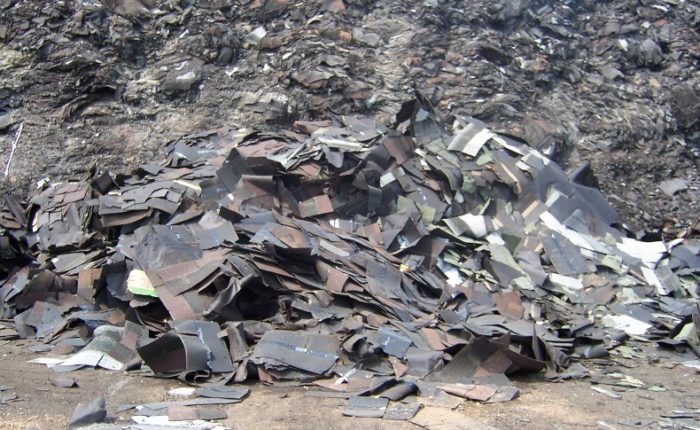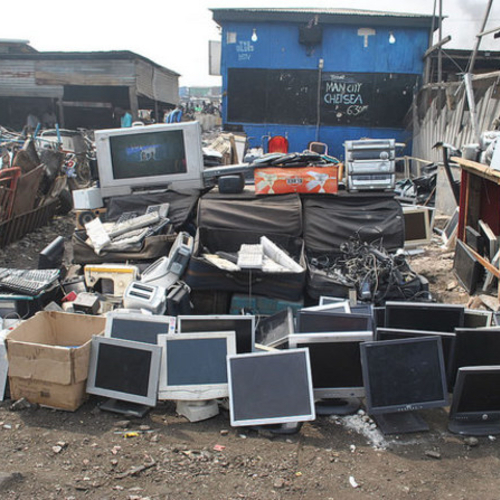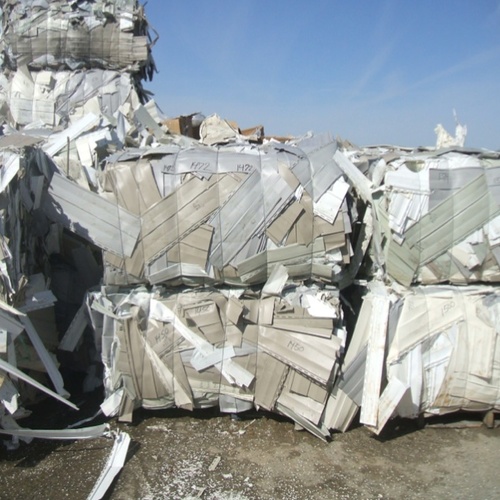Tear-offs add up
Nearly all of the 11 million tons of asphalt shingle waste produced in a year comes from tear-offs. Recycling programs vary from state to state.Image Credit: Dan Morrison
Tear-offs add up
Nearly all of the 11 million tons of asphalt shingle waste produced in a year comes from tear-offs. Recycling programs vary from state to state.Image Credit: Dan Morrison
From roof to road
Asphalt roofing shingles can be ground up and incorporated into new hot-mix asphalt or turned into a driveway base. The paving industry is the major end-user of reprocessed shingles, but overall the recycling rate is still low.Image Credit: Dan Morrison
A mix for driveways
A combination of ground asphalt shingles, ground asphalt and concrete makes a good temporary driveway during construction, and a good base for paving later.Image Credit: Dan Morrison
UPDATED 8/16/2011
Asphalt shingles are the roofing of choice for a majority of U.S. homes. And each year, in the process of manufacturing, installing and eventually replacing them, the construction industry produces an estimated 11 million tons of shingle waste.
That’s roughly the capacity of a quarter-million fully laden tractor-trailers, which when lined up end to end would stretch from New York to Los Angeles.
Most of the waste now goes to landfills. But unlike processed gypsum drywall, which often goes begging for markets, recycled asphalt shingles have inherent value because of their high petroleum content.
William Turley, executive director of the Construction Materials Recycling Association, a trade group, estimates that one-third of the waste is currently recycled, and he expects that to continue rising.
That’s good news. As recently as 2007, a consultant to the CMRA reported asphalt shingling recycling was “rarely practiced in some states.” It’s still hampered by health and regulatory issues, but there’s a good reason for Turley’s optimism.
“Shingle recycling has grown tremendously in the past 10 years,” he says. “The reason is that it’s very profitable. Shingles contain bitumen, the binding agent in asphalt pavement. It’s oil — and oil is a little expensive right now.”
However, as is the case with other forms of C&D waste, shingle recycling is a hit-or-miss proposition that varies from state to state, goes up and down with changing market conditions, and is not systematically tracked by any private or government agency. For a state-by-state list of shingle recyclers, check the map at the CMRA web site.
Potential uses for processed shingles
Asphalt shingles, which account for two-thirds of the U.S. residential roofing market, are made from a fiberglass or organic backing, asphalt cement, a sand-like aggregate and mineral fillers such as limestone dolomite and silica. These are the basic ingredients of hot-mix asphalt used in road construction, which helps explain why the paving industry is the No. 1 end user of reprocessed shingles.
There are a variety of other potential uses, too:
Cold patch for repairing potholes. The CMRA report notes that ground-up shingles mixed with aggregate and an emulsion can be used for patching roads. In fact, the mix actually improves performance because of the fiberglass or cellulose content of the shingles.
Aggregate in road construction. Ground and screened shingles can be mixed with gravel and used to cover unpaved roads, minimizing dust, reducing vehicle noise and longer road life. Combined with ground asphalt and concrete, ground shingles also make a good road base for driveways (for a closer look at how one Connecticut business handles shingles for this use, check this video ).
Manufacturing new shingles. Some shingle manufacturers have tried using factory scraps to make new shingles, with mixed success.
Energy recovery. Shingles have an energy content of as much as 20,000 Btu per pound, the report says, and the practice of using scrap as a fuel supplement is “an established market” in Europe. Air emission regulations in the U.S. appear to be one impediment for a wider use of scrap shingles as fuel, but Turley says he knows of some cement manufacturers that use old shingles as fuel.
Although all of these end uses are possible, the patchwork of state regulations and the lack of any reliable national reporting system makes it impossible to say where any or all of them are actually put in practice.
Roadblocks for wider recycling
Two things stand in the way of higher recycling rates: health concerns related to their asbestos content, and a lack of uniform state standards allowing them to be used in hot-mix asphalt for public road projects.
Asbestos is a naturally occurring mineral with a number of excellent working characteristics. Unfortunately, it’s also a known human carcinogen. Asbestos bound up in roofing shingles or other roofing products isn’t a threat — unless it’s released as dust when shingles are ground during reprocessing. And that makes state health officials nervous.
It has been years since manufacturers used asbestos in roofing shingles. But it’s common practice to apply new shingles over old, so a contractor tearing off three layers or shingles might well run into some that contain asbestos. In addition, asbestos is still used in some roofing products, such as roof cements and mastics (the CMRA report notes that more than half of the 3,500 tons of asbestos imported into the U.S. in 2007 went into roofing products).
Some shingles manufactured into the late 1970s contained significant amounts of asbestos — some as much as 50% — so the threat that contaminated shingles will find their way into the waste stream is there.
In reality, asbestos turns up in an extremely low number of shingle samples. Massachusetts requires shingle recyclers to test each batch not once but twice. Any shingles that are found to contain asbestos must be landfilled, where the asbestos is safely sequestered.
Sean Anestis, who owns a shingle recycling company called Roof Top Recycling Inc. in Boxborough, Mass., tests every load that comes through his gates but says he “rarely finds” any containing asbestos. He handles up to 30,000 tons of shingles per year. In testing 40 samples per day, Anestis gets two or three hits a year. “You have a better chance of getting hit by a car on your way home from work than being exposed to asbestos,” he says.
In fact, one study available through the CMRA found asbestos showed up in only about 1.5% of more than 27,000 samples.
Another potential health threat are polycyclic aromatic hydrocarbons (or PAHs) shingles contain by virtue of their petroleum content. The U.S. Environmental Protection Agency has identified seven PAHs that are “probable human carcinogens,” according to the report written for the CMRA, while separate studies have linked an increased risk of certain cancers among roofers and asphalt workers because of their exposure.
Although there’s a potential for these compounds to get into the environment via shingle recycling, no conclusive studies seem to be available.
Road asphalt, state-by-state
If the best-known use for recycled roof shingles is in hot-mix asphalt, there’s no national standard regulating the practice in the U.S. Some states have adopted specifications for using old shingles in road asphalt, but others haven’t. And without this state “spec,” highway officials won’t permit ground up shingles to be used in new asphalt. Even where it is permitted, some states limit it to non-public uses, such as driveways and retail parking lots, rather than state highways.
The practice is spotty. California, for example, has no state spec, says Turley. In Illinois, the state highway department hasn’t developed one, while the Illinois Tollway authority has.
A national map developed by CMRA shows roughly half the states in the country permit the practice in one form or another. The rest, including many Western states, don’t.
Overall, about 1 million tons of reclaimed asphalt shingles went into new hot-mix last year, according to the National Asphalt Paving Association. That’s less than 10% of the total waste stream, but still a big jump over previous years.
Where it can be used, the upward limit of old shingles to hot-mix asphalt seems to be relatively small, 5%. At that level, it may actually improve the properties of the mix; beyond that, pavement gets too brittle.
A fact sheet distributed by the Northeast Recycling Council says that using hot-mix asphalt with a 5% recycled shingle content can shave as much as $2.80 per ton off the cost of hot mix while improving the quality of the paving. With that in mind, wider adoption of state standards on using reclaimed shingles would not only mean more business for recyclers but also has the potential to lower highway construction and repair costs for taxpayers.
There also are potential problems with the practice. One North Carolina paving company I spoke with said it has stopped using shingles in its hot-mix for at least two reasons. First, the shingle manufacturer they had been getting virgin scrap from for free began charging for it. Second, bits of fiberglass from ground shingles would stick up in the road when mixed with fresh asphalt. Ground shingles also can be dusty, and if they sat in the weather too long they degraded. In all, the company found it more advantageous to scrape off the top layer of asphalt on existing roads and use that to supplement new asphalt rather than use old shingles.
But, says NAPA engineer Dave Newcomb, paving companies have a powerful incentive to use more reclaimed shingles because the practice allows them to replace as much as 20% of the asphalt cement they buy, a major savings.
Newcomb says grinding shingles to a fairly fine consistency, to 3/8 in. or less, eliminates the chunky texture of asphalt. The real problem with grinding up shingles is that the process involves a “fair amount of work” and is more successful in urban areas than rural areas because of economies of scale.
Trying to make a buck
One of the chief incentives for making more of an effort to recycle construction debris is a better bottom line. Landfill tipping fees can be steep (this, too, varies by state), and culling out waste that can be recycled can pay dividends for builders.
Anestis, for example, charges between $60 and $80 per ton for roofers and disposal contractors to drop off asphalt shingles. That’s a good savings over the $70 to $120 he says landfills around the state charge.
But the economics of recycling can be complicated. In Massachusetts, Anestis has to pay to dispose of the shingles he processes because he doesn’t grind them himself. His operating margin is the difference between what he charges to take in shingles and what he pays to get rid of them.
In another state, he said, a processor might have a better market for ground shingles, allowing the processor to charge builders lower tipping fees.
In other words, shingle recycling in one state might bear no resemblance to recycling in another.
Weekly Newsletter
Get building science and energy efficiency advice, plus special offers, in your inbox.
















3 Comments
Recycling construction materials
Reusing tear off roofing material really makes sense, there is also a lot of scrap wood from new housing projects getting landfilled that could pelletized for future use.
Think reuse before refuse
This is a very enlightening piece about the potential and need to recycle roofing shingles. While there may be some hurdles to reaching wider recycling rates, it's important to consider recycling before sending the shingles to the landfill. With many home and building owners looking to go green by updating their roofs to cool or green roofs, dark asphalt shingle removal is sure to increase. So it will be important to help streamline this recycling effort.
Asphalt Shingle Recycling forum
Well written article Scott. We will be tackling many of these issues and more at the 5th Annual Asphalt Shingle Recycling Forum in Dallas Oct 27-28, at which I'll be speaking on the topic of Educating Roofing Contractors About Recycling. http://www.shinglerecycling.org for more info.
A simple thing that homeowners can do to encourage shingle recycling is ask their professional roofing contractor whether they recycle and select one that does.
Pre-sorting materials off the roof is a good idea. Generally, what gets recycled is shingles, felt, and nails. Flashing, wood, cardboard, packaging etc should be kept separate for recycling on their own - often they can be placed on top of the load of shingles for recycling at the same place.
Wood in particular is an undesirable contaminant in pavement. Try to keep wood out of the mix.
The most frequently asked question is: what about nails? Nails don't have to be separated by hand - they are separated by a magnet on the shingle grinder and get recycled too. Don't worry - they don't go into the pavement!
Log in or create an account to post a comment.
Sign up Log in